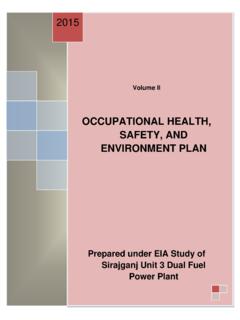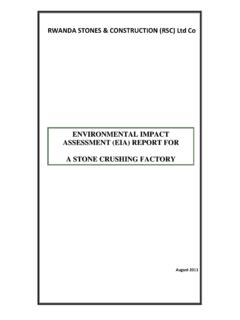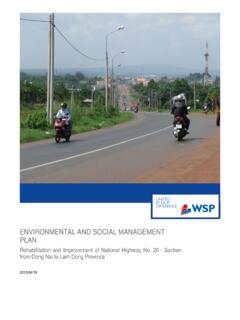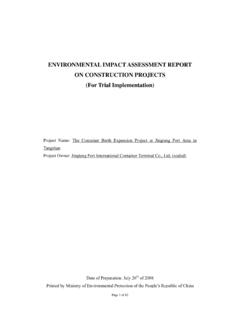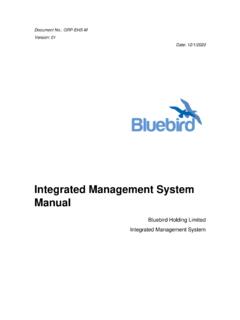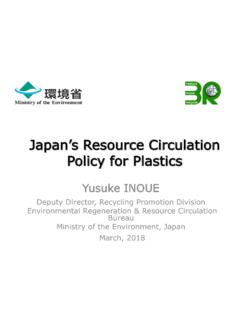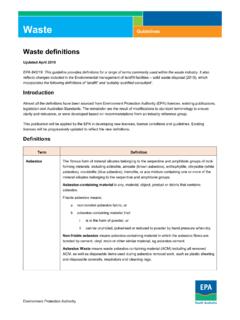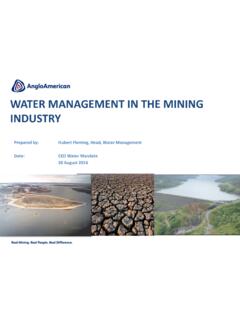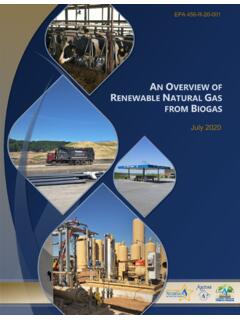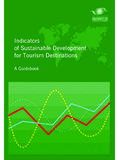Transcription of Petrochemicals Manufacturing - MIGA
1 Multilateral Investment Guarantee Agency Environmental Guidelines for Petrochemicals Manufacturing Industry Description and Practices Natural gas and crude distillates such as naphtha (from petroleum refining) are used as feedstocks to manufacture a wide variety of Petrochemicals which are in turn used for the manufacture of a variety of consumer goods. The description of petrochemical processes and products presented here is for illustrative purposes only. The basic Petrochemicals manufactured by cracking, reforming, and other processes include olefins (including ethylene, propylene, butylenes, and butadiene) and aromatics (including benzene, toluene, and xylenes).
2 The capacity of naphtha crackers is generally of the order of 250,000 to 750,000 metric tons per year (tpy) of ethylene production. Some petrochemical plants also have alcohol and oxo-compounds Manufacturing units on-site. The base Petrochemicals or products derived from them along with other raw materials are converted to a wide range of products including resins and plastics (such as low density polyethylene (LDPE), high density polyethylene (HDPE), linear low density polyethylene (LLDPE), polypropylene, polystyrene, and polyvinyl chloride (PVC)); synthetic fibers (such as polyester and acrylic); engineering polymers (such as acrylonitrile butadiene styrene (ABS)); rubbers (including styrene butadiene rubber (SBR) and polybutadiene (PBR)); solvents.
3 Industrial chemicals (including those used for the manufacture of detergents such as linear alkyl benzene (LAB), coatings, dyestuff, agrochemicals, pharmaceuticals, and explosives). A number of alternative methods are available to manufacture the desired products. (Further details of typical processes and products are provided in the annex.) Waste Characteristics Fugitive air emissions from pumps, valves, flanges, storage tanks, loading and unloading operations, and wastewater treatment are of greatest concern. Some of the compounds released to air are carcinogenic or toxic. Ethylene and propylene emissions are of concern because of their fate processes which lead to the formation of oxides which are extremely toxic.
4 Compounds considered carcinogenic that may be present in air emissions include benzene, butadiene, 1,2-dichloroethane, and vinyl chloride. A typical naphtha cracker at a petrochemical complex may annually release about 2,500 emetric tons of alkenes (such as propylenes and ethylene), when producing 500,000 metric tons of ethylene. Boilers, process heaters, flares, and other process equipment (in some cases may include catalyst regenerators)are responsible for the emission of particulates, carbon monoxide, nitrogen oxides (200 metric tons per year), and sulfur oxides (SOx) (600 metric tons per year based on a 500,000 metric tons per year of ethylene capacity).
5 The release of volatile organic compounds (VOCs) to air depends on the products handled at the plant and may include acetaldehyde, acetone, benzene, toluene, trichloroethylene, trichlorotoluene, and xylene. VOC emissions are mostly fugitive and depend upon the production processes, material handling and 461 Petrochemicals Manufacturing 462 effluent treatment procedures, equipment maintenance, and climatic conditions. VOC emissions from a naphtha cracker range from to 10 kilograms (kg) (75% are alkanes, 20% unsaturated hydrocarbons about half of these is ethylene, and remaining 5% are aromatics) per metric ton of ethylene; to kg (45% of these being ethylene dichloride, 20% being vinyl chloride, and 15% being chlorinated organics) per metric ton of product in a vinyl chloride plant; 3-10 kg per metric ton of product in a SBR plant; kg per metric ton of product in ethyl benzene plant; kg per metric ton of product in ABS plant; kg per metric ton of product in a styrene plant; and kg per metric ton of product in a polystyrene plant.
6 Petrochemical units generate wastewaters from process operations (such as vapor condensation), cooling tower blow down, and storm water run off. Process wastewaters are generated at a rate of about 15 cubic meters per hour (m3/hr) (based on a 500,000 metric tons per year ethylene production) and may contain biochemical oxygen demand (BOD5) (100 mg/L), COD (1,500-6,000 mg/L), suspended solids (100-400 mg/L), and oil and grease (30-600 mg/L). Phenol levels of up to 200 mg/L and benzene levels of up to 100 mg/L may also be present. Petrochemical plants also generate solid wastes and sludges, some of which may be considered hazardous because of the presence of toxic organics and heavy metals.
7 Spent caustic and other hazardous wastes such as distillation residues associated with units handling acetaldehyde, acetonitrile, benzyl chloride, carbon tetrachloride, cumene, phthallic anhydride, nitrobenzene, methyl ethyl pyridine, toluene diisocyanate, trichloroethane, trichloroethylene, perchloroethylene, aniline, chlorobenzenes, dimethyl hydrazine, ethylene dibromide, toluenediamine, epichlorohydrin, ethyl chloride, ethylene dichloride, and vinyl chloride may be generated in significant quantities. Accidental discharges as a result of abnormal operation especially from polyethylene and ethylene-oxide-glycol plants in a petrochemical complex can be a major environmental hazard releasing large quantities of pollutants and products into the environment.
8 Plant safety and fire prevention and control procedures should be in place. Pollution Prevention and Control Petrochemical plants are typically large and complex, where the combination and sequence of processes is usually very specific to the characteristics of the products manufactured. Specific pollution prevention or source reduction measures are best determined by technical staff. However, there are a number of broad areas where improvements are often possible and site specific emission reduction measures in these areas should be designed into the plant and targeted by plant management. Areas where effort should be concentrated include: Reduction of Air Emissions Minimize the leakages of volatile organics (including benzene, vinyl chloride, and ethylene oxide) from valves, pump glands (use mechanical seals), flanges, and other process equipment by following good design practices and equipment maintenance procedures.
9 Use mechanical seals, where appropriate. Minimize losses from storage tanks, product transfer areas, and other process areas by adopting methods such as vapor recovery systems and double seals (for floating roof tanks). Recover catalysts and reduce particulate emissions. Use low NOx burners to reduce NOx emissions. Optimize fuel usage. In some case, organics that cannot be recovered, are effectively destroyed by routing them to flares and other combustion devices. Elimination/Reduction of Pollutants Use non-chrome based additives in cooling water. Use long life catalysts and regeneration to extend the cycle. 463 Petrochemicals Manufacturing recycling / reuse Treatment Technologies Air Emissions Recycle cooling water and treated wastewater to the extent feasible.
10 Control of air emissions normally includes the capturing and recycling or combustion of emissions from vents, product transfer points, storage tanks, and other handling equipment. Recover and re-use spent solvents and other chemicals to the extent feasible. Improved Operating Procedures Catalytic cracking units should be provided with particulate removal devices. Particulate removal technologies include fabric filters, ceramic filters, wet scrubbers, and electrostatic precipitators. Gaseous releases are minimized by condensation, absorption, adsorption (activated carbon, silica gel, activated alumina, and zeolites), and in some cases using biofiltration and bioscrubbing (using peat/heather, bark, composts, and bioflora for treating biodegradable organics), and thermal decomposition.




